When War Jitters Recede, The Market May Launch A Strong Move…Here’s Why
New Highs are SLOWLY increasing,
but are still not rising consistently above 20 on the week, while New Lows are
dead on our RS/EPS lists. The market environment is improving slowly but
surely, as more indications of breadth materialize, albeit at a far less-than-optimum pace. There is a
TON of stimulus out there in the US and globally, both
monetarily and fiscally. There is evidence emerging that the economy is
improving domestically. Resources are strong, as are resource currencies. Gold
and commodities have broken out and launched new bull moves. Bonds are showing
evidence of peaking, globally.
Yet the internal
dynamics of the market show a pretty clear picture — selling pressure has dried
up almost completely, yet buying power remains muted. We suspect the reasons
for this are many-fold. After so many false rallies, investors are cautious and
doubtful of any potential rally. Corporations are making more money but mostly
from cost-cutting, and management is cautious about forward-looking optimistic
statements in the new era of potential liability for such words. Corporations
are also holding back as much as possible on new capital spending and new hiring
until the economic recovery becomes stronger and clearer and until the war mess
seems clearer. And investors are also concerned about the outcome of war.
Last week, we shocked some investors with our summary of lots of intelligence services about the war.
Yet I strongly believe it is critical for investors to stay as close as possible
to war news, since it has the potential to have such a huge impact on virtually
any investment. This last week brings news of a serious breakdown in Bush’s
pro-war preparations, as the Turks are pulling back on support with the new
government’s concern over Kurdish power after Iraq falls. Basically, like
children, the US allies are fighting over the spoils of the war before those
spoils even materialize. But this in-fighting is now likely to delay action by
the US until resolved (meaning a longer waiting period for the market).
And, the big question remains, what do we do with Iraq and its oil after Saddam
is removed? Post Afghanistan has been a complete disaster. Investors should
consider that the market reaction to war might be very different this time than
it was in the last Gulf war, where it was clear that the conflict was over and
what was going to happen down the road. In this war, Iraq is just one of many
terrorist states that Washington wants to deal with. It is not clear how Iraq
will be ruled or how terrorist response will trigger further conflicts. The
runaway bullish reaction following victory is thus less likely after this
conflict. So this wild card is muting bullish fundamentals now and is likely to
remain WILD for some time.
Equity investors may
be well advised to diversify some into foreign currencies, base and precious
metals, and particularly commodity funds and indexes like the CRB with a portion
of capital, as reflation is emerging as a dominant theme. Broad commodity
indexes with a smaller allocation to oil, like the CRB, are likely to be one of
the better bets for double-digit gains in 2003.
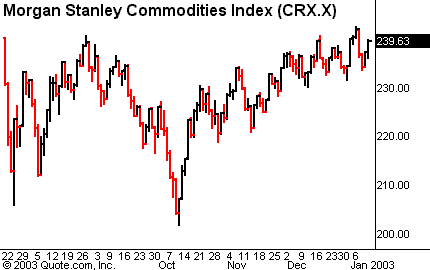
However, this year, we also
expect a more decent performance year out of our strategy. Once
war-jitters recede and the outlook is less risk-prone, we believe the market can
launch a strong move that will give us some catchable long opportunities before
returning to the secular downtrend. If volume, breadth, leadership, and
follow-through can emerge, we still suspect this rally could develop into
the strongest and longest bear-market rally we’ve seen since the March 2000
peak. But investors need to realize that a geopolitical-war shock to the
markets could reverse on a dime even with the broadest based upmove, so caution is
still advised.
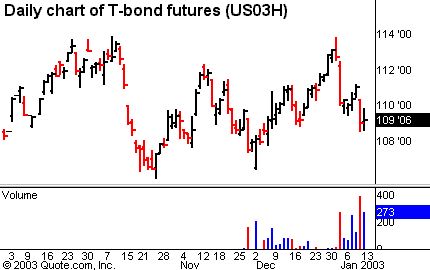
Since March 2000 the world index is down over 45%, the S&P over
48%, the IBD mutual fund index is down over 62%, and the Nasdaq has crashed over
76%. Meanwhile, since March 2000 the long/short strategy we summarize and
follow-up each week in this column has made more than 38% on a worst drawdown of
under 6%.
While this
performance is certainly underperforming our long-term growth rate, and it is
hardly thrilling to have been so heavily in cash since March of 2000, we have
managed to eke out gains with very low risk in a very dangerous market
environment where 9 out of 10 traders have been big losers.
Our official model
portfolio overall allocation remains VERY DEFENSIVE. We’re now 84% in T-bills
awaiting new opportunities, with one sole long position. Our model portfolio
followed up weekly in this column was up 41% in 1999, up 82% in 2000, up 16.5%
in 2001, and up 7.58% in 2002, an average annual gain of over 36% — all on a
worst drawdown of around 12%. We’re now up 0.51% for the year 2003.
And we’ve emphasized defense as much as making money.
Unbelievably
Top RS/EPS New Highs have still mustered up just ONE solid week of
consistent +20 or higher readings since the 7/24 lows. Yet this past week
DID show some pretty market improvement. We had readings of 19, 23, 44, 35, and 13
new highs on our Top RS/EPS New Highs list with a huge increase in breakouts to
23, a long trade, and many close calls. Let’s watch close calls from this week
and see if follow-through is continuing to expand in these issues. Bottom
RS/EPS New lows continue dismal with readings of 1, 2, 2, 4, and 4, accompanied
by just 3 breakdowns and one close call for potential short sales. So we
remain heavily on the sidelines yet optimistic— and my guess is this will
continue to be the case until there is some clarity in the Iraqi situation.
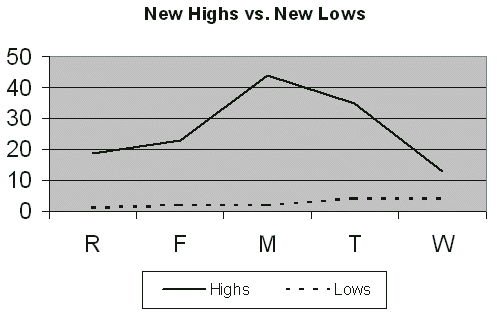
For those not
familiar with our long/short strategies, we suggest you
get my new module
where I discuss many new techniques.
Basically, we have rigorous criteria for potential long stocks that we call
“up-fuel,” as well as rigorous criteria for potential short stocks that we call
“down-fuel.” Each day we review the list of new highs on our “Top RS and EPS New
High List” published on TradingMarkets.com for breakouts of four-week or longer
flags, or of valid cup-and-handles of more than four weeks. Buy trades are taken
only on valid breakouts of stocks that also meet our up-fuel criteria. Shorts
are similarly taken only in stocks meeting our down-fuel criteria that have
valid breakdowns of four-plus-week flags or cup and handles on the downside. In
the US market, continue to only buy or short stocks in leading or lagging
industries according to our group and sub-group new high and low lists. We
continue to buy new signals and sell short new short signals until our portfolio
is 100% long and 100% short (less aggressive investors stop at 50% long and 50%
short). In early March of 2000, we took half-profits on nearly all positions and
lightened up considerably as a sea change in the new-economy/old-economy theme
appeared to be upon us. We’ve been effectively defensive ever since.
Upside breakouts
meeting up-fuel criteria (and still open positions) so far this year are:
Port Financial
(
PORT |
Quote |
Chart |
News |
PowerRating)
@40.99 (46.45)-now use 43 ops to lock in profits, and new this week
WebMD
(
HLTH |
Quote |
Chart |
News |
PowerRating) @9.44
(9.55) w/ an 8 ops. Continue to watch our NH list and buy flags or
cup-and-handle breakouts in NH’s meeting our up-fuel criteria — but be sure to
only add names that are in leading groups, and now only add two trades per week
once again until leadership and follow-through improve (soon?).
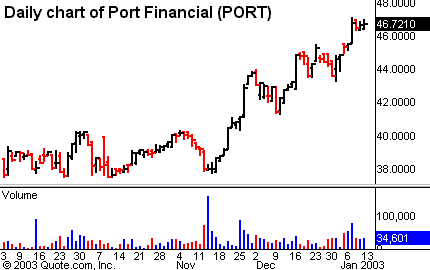
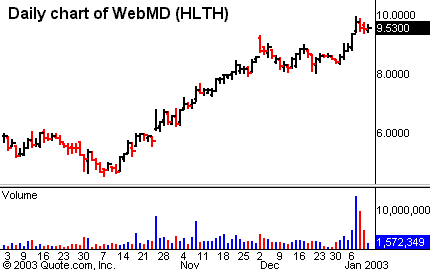
On the short side
this year, we’ve had breakdowns from flags (one can use a down cup-and-handle
here as well) in stocks meeting our down-fuel criteria (and still open
positions) in: NONE. Continue to watch our NL list
daily and to short any stock meeting our down-fuel criteria breaking down
out of a downward flag or down cup-and-handle that is in a leading group to the
downside but only add up to two in any week (and only in the weakest groups)
until we get better breadth numbers on the downside and better leadership.
We’ve got nearly all
the ingredients we need to confirm the “B†wave move when been anticipating for
months — a rally that will at least last into the first quarter. We’re starting
to get more breadth and better quality signals on the upside. Economically
evidence is developing of a pickup. We’ve got enough monetary and fiscal
stimulus in the bag to fuel growth for much of the year. Yet international war
could alter this scenario in a heartbeat. Strong trends seem to be developing
in foreign currencies, gold, commodities, and commodity currencies, and
aggressive investors should not miss these moves. But tread lightly in any
avenue, as there are almost no investments that a surprise Iraq development
won’t effect. In the US market, WE MUST CONTINUE TO LET
THE MARKETS CONFIRM THAT THERE IS ENOUGH STRENGTH TO SAFELY PARTICIPATE IN THIS
RALLY. And that still requires stronger evidence of clear new group
leadership, substantially more breakouts of close-calls or stocks meeting our
criteria, better and more consistent follow-through by those close calls and
criteria stocks that do breakout, and substantially more breadth of new highs
and breakouts on our list. Watch and wait for opportunities to improve. Don’t
forget that profits can come VERY QUICKLY when
things all line up correctly — like the nearly 50% gain we took from the late
’99-early 2000 three months. But patience is required to not give our big gains
back in a less than optimal period. Set your sights, but don’t pull the trigger
yet.
Mark
P.S. If you would like to learn how I select
stocks with Runaway Fuel, click
here. You’ll learn the information on my new training module, which
teaches you how to trade stocks that have the potential for out-sized gains.
